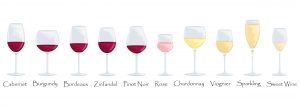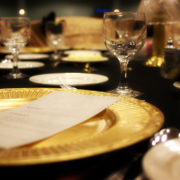May 25 is National Wine Day-Are You Asking Yourself, Which Wine Glass Do I Use?
Even though Zoom has replaced in-person meetings & events for now, how we present ourselves online is just as important as when we directly interact with someone.
Knowing the appropriate wine glass to use in business and formal-social settings gives you an air of sophistication.
The line from the movie Ocean’s Eleven says it best, “someone is always watching.”
This article will demystify and help you navigate the array of wine glasses on the market. As well, provide you with a few wine tasting etiquette tips.
First, the occasion matters-a glass with a stem is more formal than a stemless glass.
The Anatomy of a Wine Glass
Second, the type of wine that you are drinking will influence your selection.
Wine Glass Categories
Red Wine
White Wine
Rosé
Dessert Wines
Champagne
The primary distinction among glassware is the shape and size of the bowl.
Bowl Shapes & Sizes
Red Wine
Bold red wines, such as a Cabernet Sauvignon, require a larger bowl & wider opening. This design allows for aeration, which releases the wine’s deeper complexities.
Since lighter red wines, such as a Pinot Noir, have a subtler aroma, a large bowl with a narrower opening allows for proper aeration without sacrificing its delicate bouquet.
White Wine
A smaller U-Shaped bowl & opening helps maintain the wine’s cool temperature & the amount that is exposed to the air. Because white wines have more delicate bouquets, you want the notes to be channeled towards your nose and not dissipated by aeration.
Keep in mind, full-bodied white wines are served in larger bowls. For example, Chardonnay.
Rosé
Most recognizable by its flared rim
Dessert Wines
Smaller because of the wine’s high alcoholic content
Champagne
Flute
- The long vessel keeps the bubbles longer
Tulip
- Maximizes flavor over bubbles
Coupe
- Is pretty but doesn’t hold the flavor or the bubbles for very long
How to Hold a Wine Glass
- As stated in our May 16th National Mimosa Day etiquette article (Mimosa Day Etiquette), hold it by the stem, close to the base. Never hold chilled wine or champagne by the The heat from your hand will alter the profile notes.
- Holding the stem keeps our hands away from the rim & your nose. Our hands have scents (natural, soap, lotion, perfume, etc.). These fragrances can overpower the wine’s aroma.
- Holding the bowl leaves fingerprints. A dirty goblet isn’t very elegant.
- Hold stemless glasses close to the base.
The Swirl
- Swirling your wine is not pretentious-it’s functional because it releases the flavors.
- Only a slight swirl is needed. You risk spillage if the motion is too aggressive. For this reason, wine glasses are never completely filled.
- Only swirl reds, whites and Rosé Never champagne.
Expert Etiquette Tips
- Glasses with stems are called “stemware.”
- Never fill the wine glass to the rim.
- Red ⅓ full
- White ½ full
- Champagne ¾ full
- If you forget the above ratios, just remember to fill your glass to the widest part of the
- I typically wait approximately 15-20 minutes before using a recently washed glass. It allows the dish detergent’s scent to evaporate and not interfere with the wine’s taste.
Third, now that you know which glasses to use, the real question is do you really need all of them? No!
So why are there so many different wine glasses? It’s simple-to increase sales, the luxury glass company Riedel designed varietal-specific glass collections. The marketing strategy was that matching the different shapes and sizes to the wine type would enhance the tasting experience.
If you are a beginner who simply desires a nice glass of vino during dinner, one universal red wine, white wine & champagne flute are nice additions to your tableware setting. If you are not quite an oenophile but more advanced than a dilettante, two different red & white wine glasses (one for light wines and one for full-bodied wines) are sufficient.
Don’t get duped into buying a million different varieties. With a few exceptions (i.e. the red plastic BBQ cup), what matters most is the wine’s taste, not the glass.
Finally, knowing the appropriate glass to use can be fun and if you’re invited to a virtual wine tasting or Happy Hour event you can participate without feeling the anxiety of being viewed as unrefined.
It is worth noting that if you observe someone who is using the incorrect glass, it is inappropriate to point it out. Embarrassing a person is always poor etiquette. You should be more concerned that he or she is enjoying him or herself.
Remember, the highest level of proper etiquette is making others feel comfortable in your presence.
Now that you know the basics, I hope you enjoy your next glass of wine. Cheers!





